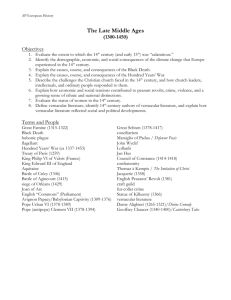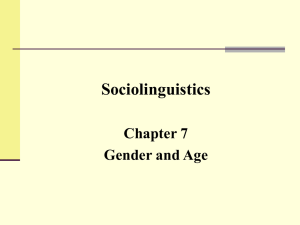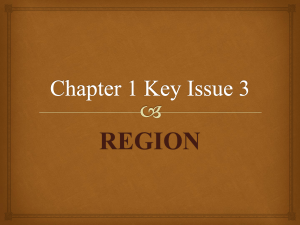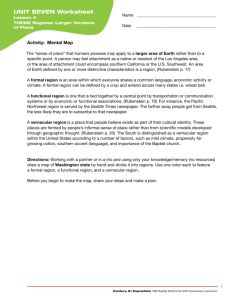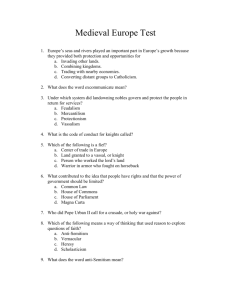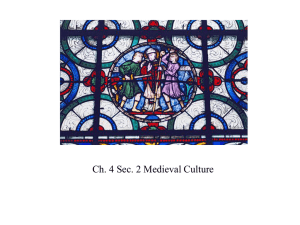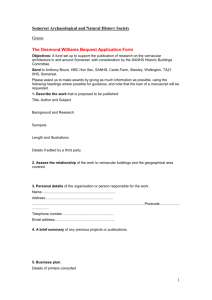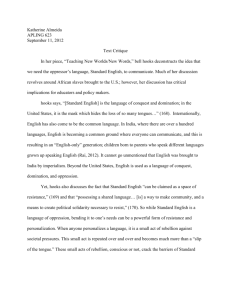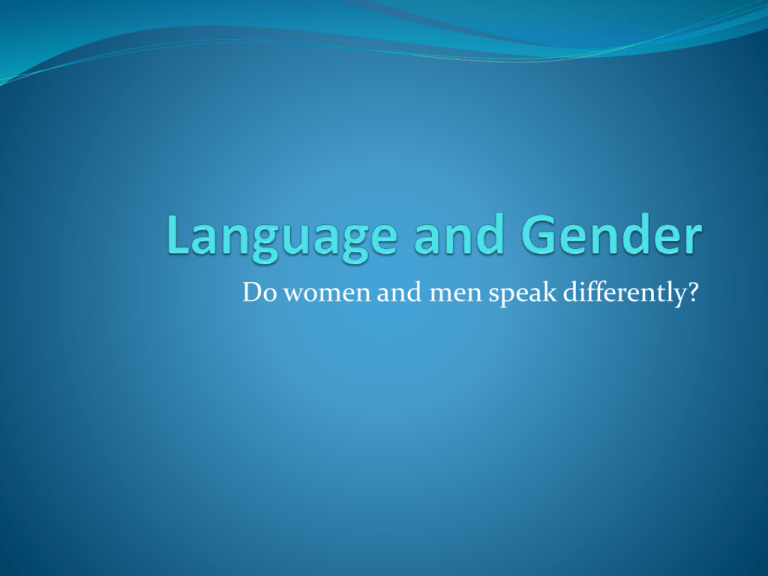
Do women and men speak differently?
Differences between terms sex and gender:
sex more often associated with biological characteristics
gender more appropriate for discussing socio-cultural
behaviour (incl. speech)
Also, gender allows for description of m. and f. behaviours
along a continuum.
Gender-exclusive speech differences: highly structured
communities
Women and men do not speak in exactly the same way as each
other in any community.
An extreme example Amazonian Indians; men must marry
outside their own tribe so the men and women in the
coummnity speak different languages
A less extreme example Gros Ventre North American Indian
tribe; ‘bread’ is [kja'tsa] for women and [dʒa'tsa] for men
Traditional / conservative styles of Japanese women have to
prefix nouns with o- , a marker of polite or formal style
Modern Japanese such distinctions more related to formality
than to gender; ‘men’s’ forms casual, coarse, macho …
… ‘women’s’ forms used by everyone in public contexts.
Some languages signal the gender of the speaker in the
pronoun system.
Again, in Japanese: ore (‘I’) used only by men, boku used
mainly by men; women traditionally expected to use more
formal atashi, watashi and watakushi
Exercise: Do English pronouns encode the gender of the
speaker?
Social status and power differences
Very hierarchical societies linguistic differences just one
dimension
e.g. in Bengali societies (apparently) wives are not
permitted to use their husbands’ names as they (the wives)
are supposed to be subordinate
Gender-exclusive speech forms reflect gender-exclusive
social roles
i.e. women and men have different responsibilities, and
everyone in the community knows what they are
Gender-preferential speech features: social
dialect research
Western urban communities social roles overlap, speech
forms also overlap
Different quantities or frequencies of the same forms
Collected data (for English) shows that women use more –
ing [iŋ] and fewer -in’ [in] pronunciations
In Canada, the pronunciation of [l] in chunks such as il y a
and il fait differs between women and men
In Australia, some men and women pronounce the initial
sound in thing as [f], but men do it more than women
Gender-preferential speech features: social
dialect research
Women preference for standard forms
Men preference for vernacular forms
Exercise: What would you predict for [h]-dropping
patterns? Is it more likely that women or men drop most
[h]s?
Gender and social class
Features which differ in the speech of women and men in
Western communities also distinguish the speech of people from
different social classes.
How does gender interact with social class?
Does the speech of women in one social class resemble that of
women from different classes, or does it more closely resemble
the speech of the men from their own social class?
Answer is complicated, and it depends on the linguistic feature.
Some general patterns can be identified.
In every social class men use more vernacular forms than
women.
Vernacular [in] by sex and social group in Norwich
(Trudgill, 1983a)
100
90
80
70
60
50
40
30
20
10
0
men
women
1
2
3
4
5
Gender and social class
Lowest and highest social groups women’s speech closer
to that of the men in the same group; class membership
more important than gender identity?
Social group 2 women’s score of 3% for vernacular forms
is closer to that of women in group 1
Exercise: Recent research suggests that Japanese women
and men may use grammatical patterns with different
frequencies. Are you aware of any differences in the
grammar of English-speaking women and men? What
pattern of gender differences would you predict for
grammatical variables such as multiple negation?
Gender and social class
Across all social groups women generally use more standard
forms than men.
Standard forms overtly prestigious
Vernacular forms preferred by men, not admired overtly by
the society as a whole, and not cited as the ‘correct’ forms
Pattern found in all Western speech communities
Described by Trudgill (1983) as ‘the single most consistent
finding to emerge from sociolinguistic studies over the past 20
years’
Also evident from a very young age – young boys use more [in],
more consonant cluster simplification [læs] for last, [təʊl] for
told, and are more likely to pronounce th [ð] as [d] in this, the
and then
Gender and social class
Exercise: Consider some possible explanations for the
finding of social dialect surveys that women use more
standard froms than men. What might be the possible
influences of the following factors: social status, social
distance or solidarity, the formality of the context and
the functions of speech? How might these affect the
speech used by an interviewee in a social dialect survey?
(Bear in mind that no single explanation is likely to fit all
cases.)
Four explanations of women’s linguistic
behaviour
Social class and related status?
Women’s role in society?
Women’s status as a subordinate group?*
Function of speech in expressing gender identity (esp.
masculinity)?
1. The social status explanation
Some linguistics experts have suggested that women are more
status-conscious than men.
More aware of speech signalling social class background?
Standard speech forms associated with higher social status
Perhaps linked to paid employment? Occupation can signal
social status
Further support for this explanation in the fact that women in
NY (Labov) and Norwich (Trudgill) reported that they used
more standard forms than they actually did.
Superficially plausible, but some arguments against this
explanation.
The social status explanation (2)
Women not in paid employment more likely to rely on the
use of standard forms to claim higher social status?
No – the opposite seems to be true. (Think about their
interactions.)
Studies in NY and Belfast reflect this.
2. Women’s role as guardian of society’s values
Society tends to expect ‘better’ behaviour from women
than from men.
Boys generally allowed more freedom than girls,
misbehaviour from girls more quickly corrected.
Women designated the role of modelling correct behaviour
in the community think about primary school teachers.
This explanation may be relevant in some social groups but
what about interactions between mothers and children?
Relaxed? Informal? This is when we expect to encounter
more vernacular forms.
3. Subordinate groups must be polite
Not immediately apparent why polite speech should be
equated with standard speech. Perfectly possible to be
polite using Liverpudlian vernacular, as it is to be rude and
insulting using RP. (Think of Prince Charles, or his dad is
probably an even better example!)
Unsophisticated version women are subordinate and
therefore should be polite
More sophisticated version women are protecting ‘face’
(their own and others); this is when we start considering
the more subtle functions of speech
But whose speech is the norm – women’s or
men’s?
All the explanations so far seem to be based on the
underlying assumption that women’s behaviour is aberrant
and has to be explained – yet they are the ones who use
more standard forms!
Why should standard or ‘correct’ behaviour need
explaining?!?
What if we asked ‘why don’t men use more standard
forms’?
Exercise: what do you think might be some answers to this
question above?
4. Vernacular forms express machismo(?)
Do vernacular forms carry connotations of masculinity and
toughness?
Evidence / data subjects listen to recordings of men speaking
and then say who they think would be more likely to win a street
fight.
Norwich men tended to claim they used more vernacular forms
than they actually did. (Bit pathetic really innit!)
Vernacular forms then may have covert prestige
So, conversely, are standard forms to be associated with feminine
values and femininity?
Think about school teachers again … female domination?
Associated speech forms?
Some alternative explanations …
How are women categorised? Early social dialect studies
often used the woman’s husband’s occupation as their
major criterion!
The influence of the interviewer and the context
Who are the interviewers?
Cooperativeness and desire to accommodate
Are women more sensitive to contextual factors?
Exercise: How do you think you would speak in a social
dialect interview? What would be the effect of the context
and the interviewer’s status on your speech?
Reference:
Holmes, J. (1992) An introduction to sociolinguistics.
Harlow: Pearson Longman

